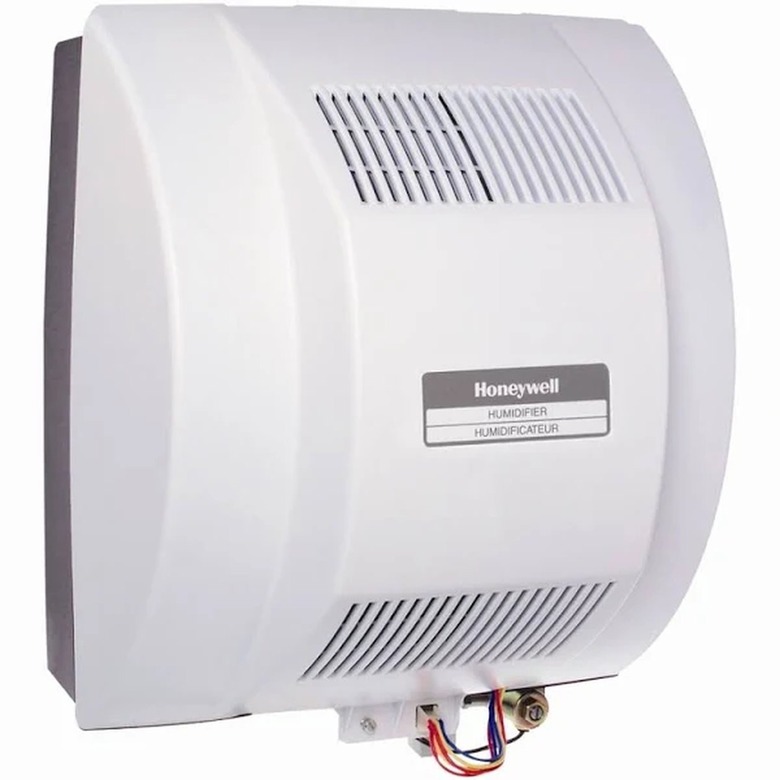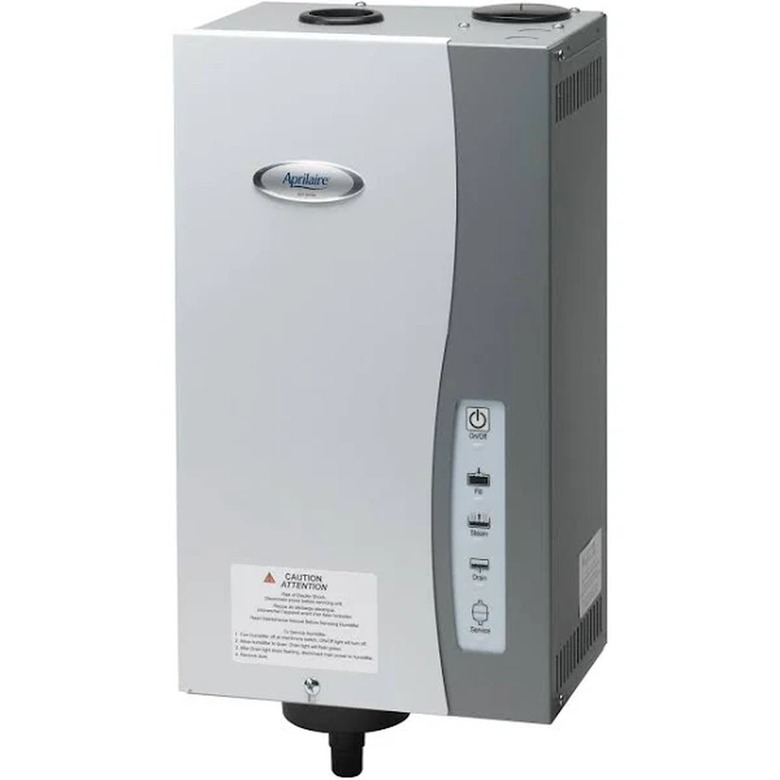The Most Common Whole-House Humidifier Problems — And How To Fix Them
We may receive a commission on purchases made from links.
A whole-house humidifier adds many benefits to your home: It relieves the dryness you experience when the furnace is running, and it's attached to the furnace return air or supply ductwork, so you never have to worry about turning individual units on and off throughout the dry winter season. However, depending on which type of whole-house humidifier you have, it has a number of auxiliary components inside and outside the housing that can potentially fail and cause the system to not perform as it should.
Because the humidifier needs a controllable water supply, there is usually a solenoid valve on the supply line controlled by a humidistat — in addition to a humidity sensor located somewhere in the house or outside the building if you use the humidifier in the summer to condition dry air from outdoors. Many problems can be traced to these components, but there are also plenty of ways the components inside the housing can malfunction, especially if you have hard water.
Typical Humidifier Setups
Typical Humidifier Setups
The humidifier itself is contained inside a square or rectangular housing mounted on the furnace assembly, along with a water supply pipe and a drain line. If you follow the supply line to the point where it connects to the main water line, you'll pass an inline valve — the solenoid valve — on your way to the main shutoff valve. Wires from the solenoid valve (which operates at 24 volts and looks somewhat like a sprinkler valve) connect to the humidistat and to the furnace transformer in the same way the furnace's thermostat connects to the furnace.
If the humidifier is a bypass model, it has an intake duct coming from the return air vent or from the furnace room, and this should have an air filter to keep dust and allergens out of the humidifier. Inside the housing is a tray near the top to hold water and distribute it over the evaporator pad, and this has a float valve to stop the water when the tray is full. The pad itself looks like a furnace air filter — underneath it, a tray at the bottom catches excess water and directs it into a drain line. A drum humidifier has no filterlike medium and has only a single tray that water-absorbent paddles pass through as the drum rotates. A steam humidifier (which looks like a tankless water heater) has a tank, a heating element to produce steam and a pipe outlet to feed steam into the ductwork.
No Water in the Humidifier
No Water in the Humidifier
If the humidifier isn't getting any water, the humidity level won't go up, even if the fan is on, and the system appears operational. There are several possible reasons:
- The main shutoff valve is closed. If it's a ball valve, make sure the handle is parallel to the pipe. If it's a gate valve, turn it counterclockwise as far as it will go. If it's a saddle valve, it's already open, and if there's no water, there may be an obstruction, meaning the valve may have to be removed and cleaned.
- The humidifier solenoid valve isn't opening. Loosen the pipe on the supply side of the valve and if water spurts out, indicating water is coming from the gate valve, test the solenoid valve by setting the humidistat to high humidity and listening for a click. If you hear nothing, have an HVAC technician test the valve with a multimeter and replace it if necessary. If you're handy, you can also DIY this.
- The float valve is stuck. If the solenoid valve is working and water isn't flowing into the tray, the float valve is probably stuck. It may start working if you move it up and down a few times manually, and it may benefit from a few squirts of spray lubricant.
Continued failure to restore the flow of water usually indicates buildup of mineral deposits somewhere in the supply line, which may have to be disassembled and cleaned. You won't have this problem if the house has a water softener or water softening system.
Humidifier Has Water But Doesn't Humidify
Humidifier Has Water But Doesn't Humidify
Depending on the type of furnace humidifier you have, a failure to humidify could signify an internal malfunction in the humidifier itself. If you have a drum-style model and you hear a humming sound, the motor may have to be replaced, but if you hear knocking sounds, the drum itself may need replacing. If you have a steam generator, the elements aren't heating up, and this may be traceable to the power supply. You may be able to rectify the situation by resetting a breaker or replacing a blown fuse.
Humidifier problems with models that use an evaporator pad are sometimes due to the buildup of mineral deposits on the pad. They can block the flow of water, and sections of the pad may remain dry, resulting in dry air coming into the furnace ducts. You may be able to restore the pad by soaking it in a tray of vinegar; if not, replace it.
Humidifiers rely on a steady supply of incoming air, and they get starved for air if the air filters are dirty. Cleaning the filters is a job you should do frequently when you have a furnace, and it's especially important to do it when the humidifier is being used. If any duct has a damper, open it all the way because if it's closed or partially closed, it could be depriving the humidifier of air.
Musty Odors in the Indoor Air
Musty Odors in the Indoor Air
Pathogens, like bacteria and mold, love humidifiers, whose only job is to increase the moisture these microorganisms need to survive. They can grow in the water inlet trays as well as the drainage trays, particularly if there's a blockage in the drain line. Drum-style humidifiers are particularly vulnerable to mold because they recycle water from a tray rather than draining it. When mold grows in the humidifier, it can circulate through the ducts and affect air quality throughout the house.
Even steam generators can promote mold growth by circulating steam through an HVAC system that has ducts exposed to cold temperatures. The steam in these ducts condenses on the duct walls, and the combination of abundant water and the warming effect of the steam provides a perfect habitat for mold. The moral of the story is to avoid steam generators if you have exposed metal ducts (fiberglass ducts are fine) because once the mold is established and you can smell it, the only solution is an expensive duct cleaning and disinfecting operation.
You can prevent mold and bacteria problems by regularly cleaning the water trays and removing the evaporator pad or drum, flushing it with clean water or a 10 percent bleach solution and letting it air dry. If you smell mold, these are the parts of the humidifier system that most need cleaning and disinfecting but don't stop there. The inside of the humidifier housing as well as the inside of the inlet and outlet vents are probably also affected. If you can't reach them yourself, they may need a professional cleaning.

